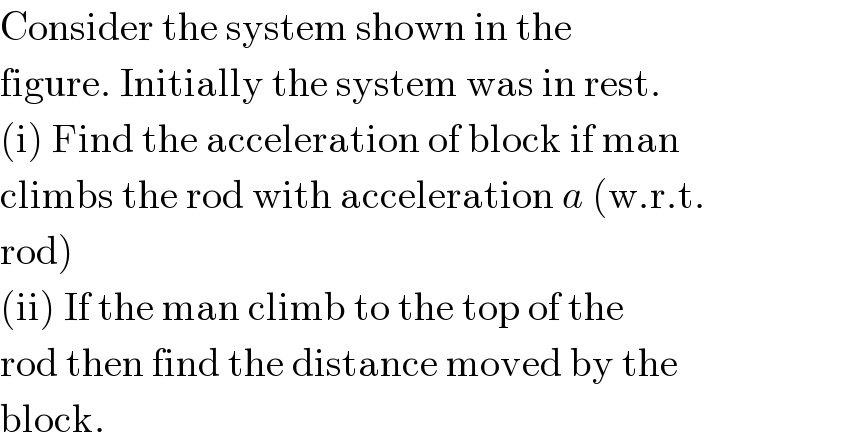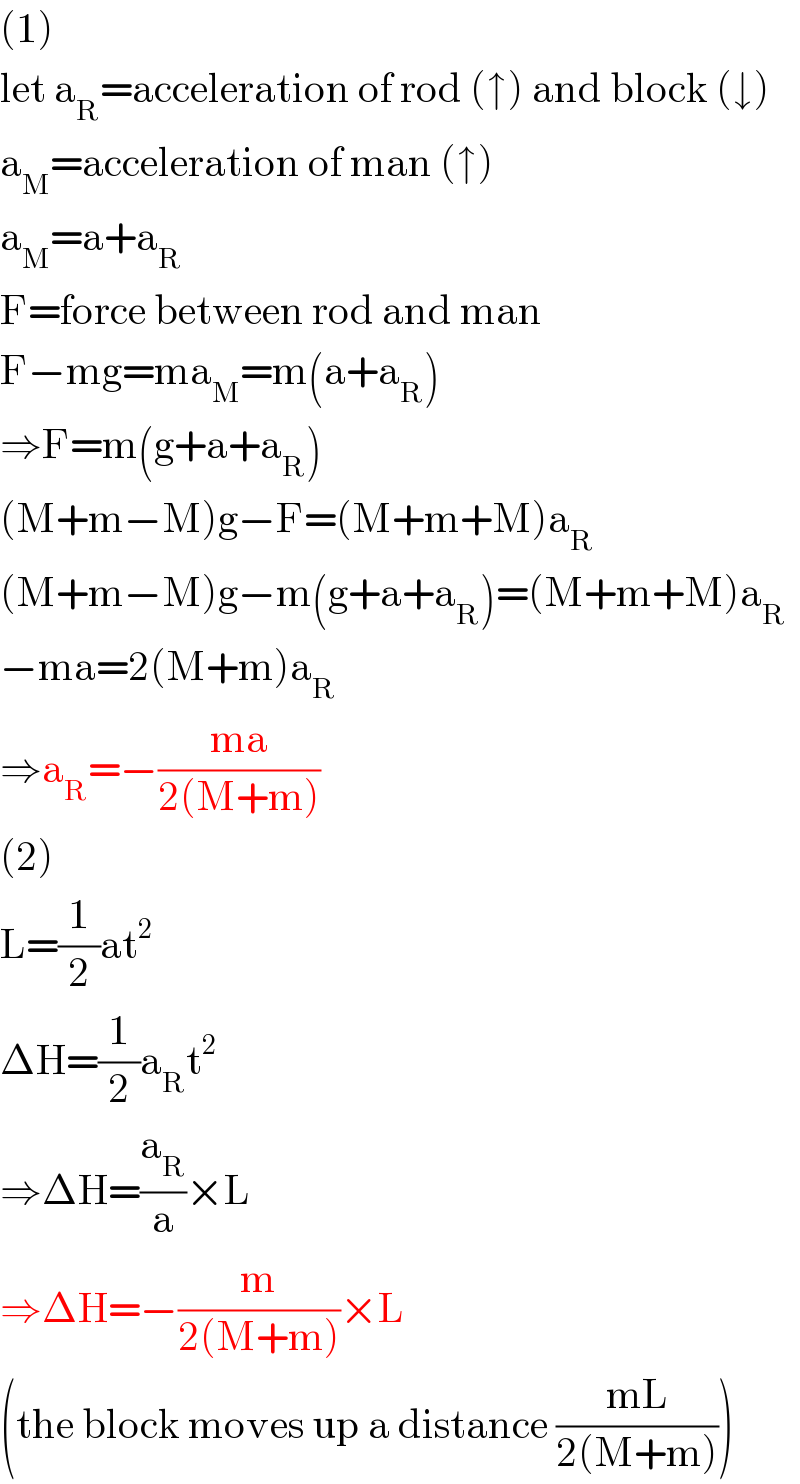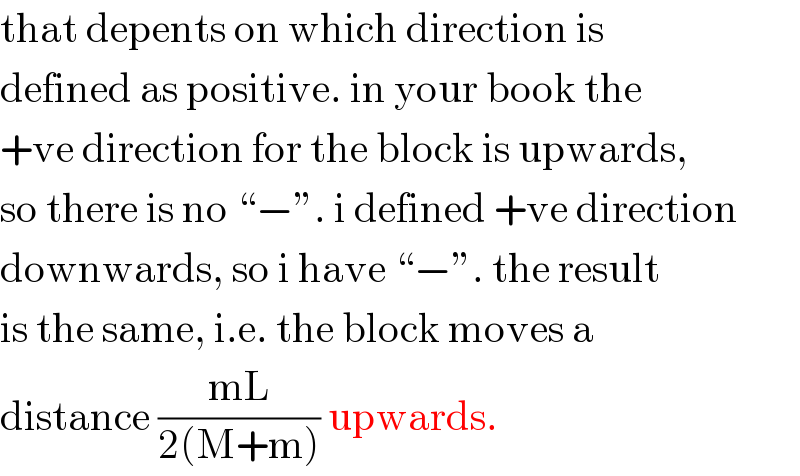
Question Number 23224 by Tinkutara last updated on 27/Oct/17

$$\mathrm{Consider}\:\mathrm{the}\:\mathrm{system}\:\mathrm{shown}\:\mathrm{in}\:\mathrm{the} \\ $$$$\mathrm{figure}.\:\mathrm{Initially}\:\mathrm{the}\:\mathrm{system}\:\mathrm{was}\:\mathrm{in}\:\mathrm{rest}. \\ $$$$\left(\mathrm{i}\right)\:\mathrm{Find}\:\mathrm{the}\:\mathrm{acceleration}\:\mathrm{of}\:\mathrm{block}\:\mathrm{if}\:\mathrm{man} \\ $$$$\mathrm{climbs}\:\mathrm{the}\:\mathrm{rod}\:\mathrm{with}\:\mathrm{acceleration}\:{a}\:\left(\mathrm{w}.\mathrm{r}.\mathrm{t}.\right. \\ $$$$\left.\mathrm{rod}\right) \\ $$$$\left(\mathrm{ii}\right)\:\mathrm{If}\:\mathrm{the}\:\mathrm{man}\:\mathrm{climb}\:\mathrm{to}\:\mathrm{the}\:\mathrm{top}\:\mathrm{of}\:\mathrm{the} \\ $$$$\mathrm{rod}\:\mathrm{then}\:\mathrm{find}\:\mathrm{the}\:\mathrm{distance}\:\mathrm{moved}\:\mathrm{by}\:\mathrm{the} \\ $$$$\mathrm{block}. \\ $$
Commented by mrW1 last updated on 27/Oct/17

$$\left(\mathrm{1}\right) \\ $$$$\mathrm{let}\:\mathrm{a}_{\mathrm{R}} =\mathrm{acceleration}\:\mathrm{of}\:\mathrm{rod}\:\left(\uparrow\right)\:\mathrm{and}\:\mathrm{block}\:\left(\downarrow\right) \\ $$$$\mathrm{a}_{\mathrm{M}} =\mathrm{acceleration}\:\mathrm{of}\:\mathrm{man}\:\left(\uparrow\right) \\ $$$$\mathrm{a}_{\mathrm{M}} =\mathrm{a}+\mathrm{a}_{\mathrm{R}} \\ $$$$\mathrm{F}=\mathrm{force}\:\mathrm{between}\:\mathrm{rod}\:\mathrm{and}\:\mathrm{man} \\ $$$$\mathrm{F}−\mathrm{mg}=\mathrm{ma}_{\mathrm{M}} =\mathrm{m}\left(\mathrm{a}+\mathrm{a}_{\mathrm{R}} \right) \\ $$$$\Rightarrow\mathrm{F}=\mathrm{m}\left(\mathrm{g}+\mathrm{a}+\mathrm{a}_{\mathrm{R}} \right) \\ $$$$\left(\mathrm{M}+\mathrm{m}−\mathrm{M}\right)\mathrm{g}−\mathrm{F}=\left(\mathrm{M}+\mathrm{m}+\mathrm{M}\right)\mathrm{a}_{\mathrm{R}} \\ $$$$\left(\mathrm{M}+\mathrm{m}−\mathrm{M}\right)\mathrm{g}−\mathrm{m}\left(\mathrm{g}+\mathrm{a}+\mathrm{a}_{\mathrm{R}} \right)=\left(\mathrm{M}+\mathrm{m}+\mathrm{M}\right)\mathrm{a}_{\mathrm{R}} \\ $$$$−\mathrm{ma}=\mathrm{2}\left(\mathrm{M}+\mathrm{m}\right)\mathrm{a}_{\mathrm{R}} \\ $$$$\Rightarrow\mathrm{a}_{\mathrm{R}} =−\frac{\mathrm{ma}}{\mathrm{2}\left(\mathrm{M}+\mathrm{m}\right)} \\ $$$$\left(\mathrm{2}\right) \\ $$$$\mathrm{L}=\frac{\mathrm{1}}{\mathrm{2}}\mathrm{at}^{\mathrm{2}} \\ $$$$\Delta\mathrm{H}=\frac{\mathrm{1}}{\mathrm{2}}\mathrm{a}_{\mathrm{R}} \mathrm{t}^{\mathrm{2}} \\ $$$$\Rightarrow\Delta\mathrm{H}=\frac{\mathrm{a}_{\mathrm{R}} }{\mathrm{a}}×\mathrm{L} \\ $$$$\Rightarrow\Delta\mathrm{H}=−\frac{\mathrm{m}}{\mathrm{2}\left(\mathrm{M}+\mathrm{m}\right)}×\mathrm{L} \\ $$$$\left(\mathrm{the}\:\mathrm{block}\:\mathrm{moves}\:\mathrm{up}\:\mathrm{a}\:\mathrm{distance}\:\frac{\mathrm{mL}}{\mathrm{2}\left(\mathrm{M}+\mathrm{m}\right)}\right) \\ $$
Commented by Tinkutara last updated on 27/Oct/17

Commented by mrW1 last updated on 27/Oct/17

$$\mathrm{that}\:\mathrm{depents}\:\mathrm{on}\:\mathrm{which}\:\mathrm{direction}\:\mathrm{is} \\ $$$$\mathrm{defined}\:\mathrm{as}\:\mathrm{positive}.\:\mathrm{in}\:\mathrm{your}\:\mathrm{book}\:\mathrm{the} \\ $$$$+\mathrm{ve}\:\mathrm{direction}\:\mathrm{for}\:\mathrm{the}\:\mathrm{block}\:\mathrm{is}\:\mathrm{upwards}, \\ $$$$\mathrm{so}\:\mathrm{there}\:\mathrm{is}\:\mathrm{no}\:``−''.\:\mathrm{i}\:\mathrm{defined}\:+\mathrm{ve}\:\mathrm{direction} \\ $$$$\mathrm{downwards},\:\mathrm{so}\:\mathrm{i}\:\mathrm{have}\:``−''.\:\mathrm{the}\:\mathrm{result} \\ $$$$\mathrm{is}\:\mathrm{the}\:\mathrm{same},\:\mathrm{i}.\mathrm{e}.\:\mathrm{the}\:\mathrm{block}\:\mathrm{moves}\:\mathrm{a} \\ $$$$\mathrm{distance}\:\frac{\mathrm{mL}}{\mathrm{2}\left(\mathrm{M}+\mathrm{m}\right)}\:\mathrm{upwards}. \\ $$
Commented by Tinkutara last updated on 28/Oct/17

$$\mathrm{OK}\:\mathrm{Thanks}. \\ $$
